Today, in food stores almost everywhere you can find food additives in food. They are everywhere even in bread. Perhaps they are not in natural products, such as meat, cereals, milk, and greens. However, it is impossible to be absolutely sure that there is no chemistry or GMOs in them. Often, a wide variety of fruits are processed using preservatives for long-term preservation of the presentation.

Food additives in food are synthetic chemicals or natural substances. Their independent eating is not possible. They are merely introduced into food in order to endow them with certain qualities, such as taste, texture, color, smell, storage time and appearance. How expedient is their use and impact on human organisms, there are ongoing discussions.
Types of food additives
From just the phrase "food supplements", many people are afraid or annoyed. And this despite the fact that humanity uses them for more than one millennium. But this has nothing to do with complex chemicals. Refers to table salt, lactic and acetic acid, spices and spices - these are also food additives. For example, carmines - dyes derived from insects, were used in ancient times to give products a purple color. Currently, the substance is called E120.
Until the 20th century, in the process of food production, manufacturers always sought to use only natural additives. Over time, with the help of food chemistry, they began to develop the production of artificial food additives with the gradual replacement of most of the natural ones. Thus, taste improvers were put on industrial streams.
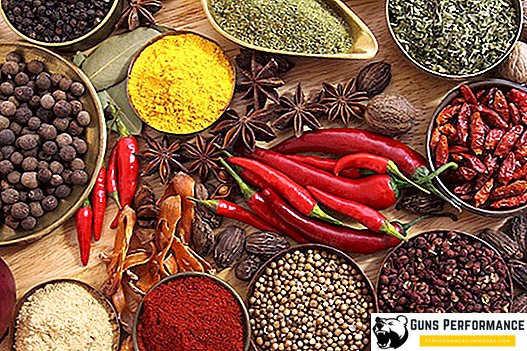
Due to the fact that most of the food additives had long names that were hardly placed on one label, for more convenient recognition of them, the specialists of the European Union developed a special labeling system. The name of each individual food additive now begins with the letter "E", which means "Europe". Following it are the numbers that indicate that a given species belongs to a conditioned group with the designation of a certain supplement. In the future, the system was refined, and now it is already an international classification.
Classification of food additives using codes
According to the classification using codes, food additives can be:
- From E100 to E181 - food dyes;
- From E200 to E296 - preservatives;
- From E300 to E363 - antioxidants, antioxidants;
- From E400 to E499 - stabilizers, preserving the consistency;
- From E500 to E575 - emulsifiers and leavening agents;
- From E600 to E637 - flavors and flavor enhancers;
- From E700 to E800 - with reserves, spare positions;
- From Е900 to Е 999 - with anti-flaming, designed to reduce foam, and sweeteners;
- From E1100 to E1105 - biological catalysts and enzymes;
- From E1400 to E 1449 - modified starches, helping to create the necessary consistency;
- From E1510 to E 1520 - solvents.
As regards acidity regulators, sweeteners, disintegrating agents and glazers, they are present in all of the above groups.
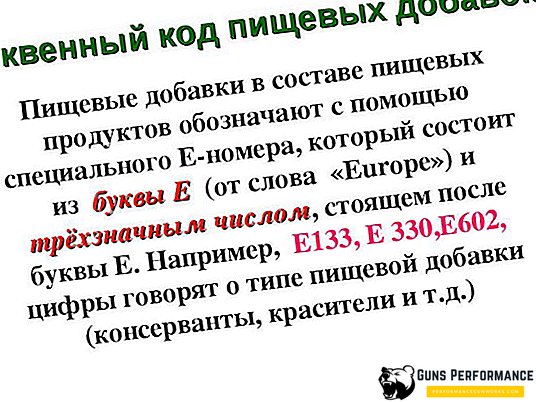
The number of food additives is increasing almost daily. As a result, new, effective and safe substances replace obsolete additives. In particular, in recent years, the so-called complex nutritional supplements, which are a mixture of additives, are becoming increasingly popular. Annually the list of approved substances is updated. For such substances, following the letter E, codes of more than 1000 appear.
Food additives classification by application
Nutritional supplements can be:
- Food dyes (E1 ...), which are food additives for recreating colors in products that were lost during processing, to enhance its intensity, to bring in certain colors. Natural dyes can be obtained from plant parts, which can be roots, berries, leaves, and flowers. In addition, food dyes may have animal origin. In natural dyes there may be a certain content of biologically active, aromatic and flavoring substances, giving the products an attractive appearance. Food dyes are: carotenoids - yellow, orange, red; lycopins - red; annatto yellow extracts; flavonoids - blue, purple, red, yellow; chlorophyll and its derivatives - green; sugar colors - brown; carmine - purple. In addition, there are dyes, produced by synthetic means. The main advantage of such substances, in contrast to natural, is a greater saturation of colors, as well as longer shelf life;
- Preservatives (E2 ...) are food additives designed to extend the shelf life of food products. Often, as preservatives can be used acetic acid, benzoic acid, sorbic acid and sulfuric acid, as well as salt and ethyl alcohol. In addition, antibiotics such as nisin, biomitsin, and nystatin can be used as preservatives. Hazardous food additives, such as synthetic preservatives, are not allowed to be added to products when they are mass produced, especially for baby food, fresh meat, bread, flour and milk;
- Antioxidants (E3 ...) are substances that prevent deterioration of fat or fat-containing products, slow down the oxidation of wines, soft drinks, and also protect vegetables and fruits from darkening;
- Thickeners (E4 ...) are food additives designed to preserve and improve the structural basis in products. With the help of thickeners products are given the necessary consistency. With the help of emulsifiers, plastic properties and viscosity can be controlled. In particular, in bakery products it is possible to achieve their longer freshness. All allowed thickeners have a natural origin. For example, E406 (agar) - is harvested from algae. With it, pates, creams, as well as ice cream are made. E440 (pectin) - extracted from peel and apples and added to jelly and ice cream. Gelatin is of animal origin and is harvested from bones, tendons, and cartilage of agricultural animals. Peas, sorghum, corn and potatoes are raw materials for starches. Emulsifiers and antioxidants E476, E322 (lecithins) are extracted from vegetable oils. One of the natural emulsifiers is egg white. In recent years, the food industry is engaged in the production of large volumes of synthetic emulsifiers;
- Amplifiers of taste (Е6 ...) are called food additives designed to make food more tasty and fragrant. In order to improve the smell and taste, four main types of additives are used, which are amplifiers of aroma, taste, acidity regulators, and also flavoring substances. Most fresh foods, such as vegetables, fish, meat, have a pronounced aroma and taste, because they contain nucleotides. With their help, the taste is enhanced, the endings are stimulated in the taste buds. During processing or storage, the number of nucleotides may decrease, as a result of which they are artificially mined. For example, using ethyl maltol and maltol can enhance the perception of fruit and cream flavors. They give a feeling of fat content to low-calorie mayonnaise, yogurt, as well as ice cream. Often added to the products of the popular monosodium glutamate with a scandalous reputation. A lot of controversy goes around sweeteners, especially around E951 aspartame, which is sweeter than sugar 200 times;
- Food flavors that are natural, artificial and identical to natural. Some contain only natural aromatic substances extracted from plants. They can be distillers for volatile substances, hydroalcoholic extracts, dry mixtures and essences. To get identical to natural food flavors, they are isolated from natural substances or by chemical synthesis. They possess chemical compounds found in animal or plant materials. Artificial ingredients can be included in artificial food flavors, and also contain parts of identical natural food flavors along with natural ones.

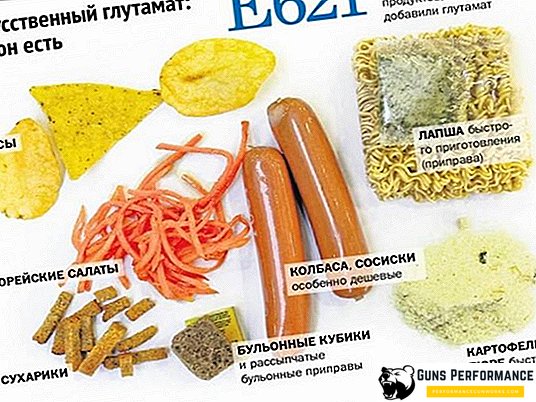
Making dairy products, manufacturers use dietary supplements. Food and dietary supplements are slightly different from each other. The first can be used separately, as a supplement to food. Food and dietary supplements can be natural or identical to them. On the territory of Russia dietary supplements make a separate category of food. Their main purpose, as opposed to the usual food additives, is the healing of human organisms, as well as their saturation with useful substances.
Useful food supplements
Anyway, not only harmful and dangerous chemical substances, but also harmless and even useful food additives can be hidden behind the E marking. Experts do not recommend suspicion of all food additives. Many substances, being additives, are extracts of natural products and plants. For example, in apples there are substances designated by the letter E. In particular, ascorbic acid - E300, pectin - E440, riboflavin - E101, acetic acid - E260.
Despite the fact that apples contain a wide variety of substances that are considered food additives, no one calls them dangerous products. The same applies to other products.
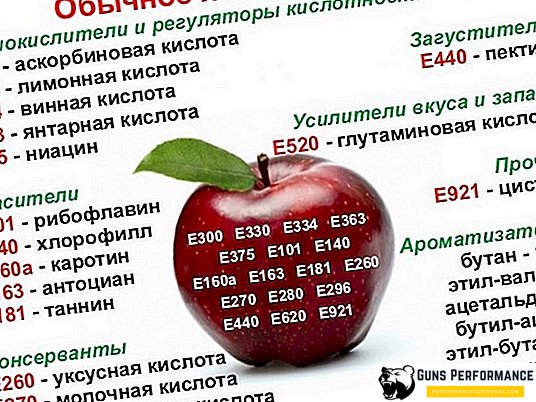
Popular supplements may be helpful, which are:
- E100 - curcumin, helping to do weight control;
- E101 - riboflavins, vitamins B2, involved in the synthesis of hemoglobin and metabolism;
- E160d - lycopene, strengthen the immune system;
- E270 - lactic acid with antioxidant properties;
- E300 - ascorbic acid or vitamin C, which helps in improving immunity, improves skin condition and brings considerable benefits;
- E322 - lecithins, supporting the immune system, improving the quality of bile, as well as blood formation;
- E440 - intestinal cleansing pectins;
- E916 - calcium iodates used in the enrichment of iodine food.
Neutral food supplements are relatively harmless.
Relatively harmless, safe food additives are:
- E140 - chlorophylls, due to which the plants become green;
- E162 - betanins, red dyes, extracted from beets;
- E170 - calcium carbonate or ordinary chalk;
- E202 - sorbitol potassium, a natural preservative;
- E290 - carbon dioxide, which helps to turn ordinary drinks into carbonated;
- E500 - baking soda, a substance that is considered relatively harmless, because the use of its large amounts negatively affects the gastrointestinal tract;
- E913 - lanolin, is used as a glazing agent, especially demanded by the confectionery industry.

Harmful food additives
Harmful food supplements are much more common than healthy ones. And they can be not only synthetic, but also natural substances. The harm of food additives E can be quite large, especially if they are used with products systematically, and to that in considerable quantities.
To date, additives are very dangerous and prohibited in Russia, which are:
- Improvers flour and bread - E924a, E924d;
- Preservatives - E217, E216, E240;
- The dyes are E121, E173, E128, E123, Red 2G, E240.
List of harmful food additives
Due to a multitude of research by specialist scientists, the lists of permitted or prohibited food additives are systematically changing. In order to receive more detailed information and always be aware of what is happening, it is best to constantly monitor such changes. Particular attention should be paid to synthetic food additives. From a formal point of view, they are not considered prohibited, but many experts have the opinion that such substances are extremely dangerous for people.
In particular, the notorious monosodium glutamate, hidden under the code E621, is a popular flavor enhancer. It is impossible to call it completely harmful, as if it is necessary for the brain and heart. When there is a shortage of this substance in the body, then he can independently develop it.
An excess of monosodium glutamate has a toxic effect, with the liver and the pancreas suffering the most. E621 consumption can lead to addiction, allergic reactions, brain damage and visual impairment. This substance has the greatest danger on children, unprepared organisms. As a rule, the packaging does not indicate what the content of sodium glutamate in products actually is.
There are many doubts and the so-called safe additive E250. It is like a universal additive, because it is used as a dye, antioxidant, preservative, and color stabilizer. Despite the fact that the harmfulness of sodium nitrate has been proven by scientists, it continues to be used in most countries of the world. It is in the composition of meat and sausage products, they can "nashpigovat" herring, sprats, smoked fish and cheese. Sodium nitrate has a negative effect on the gastrointestinal tract, is harmful for those who have cholecystitis, dysbacteriosis, and liver problems. When released into the body, this chemical can be converted into a strong carcinogen.
Almost all synthetic dyes are unsafe. They are prone to mutagenic, allergenic and carcinogenic effects. Antibiotics, which are used as preservatives, can cause dysbiosis and often they cause diseases of the gastrointestinal tract in Russia, as evidenced by statistics. Thickeners have the property of absorption of substances both harmful and beneficial, which can lead to obstruction of the absorption of minerals and nutrients necessary for the body.
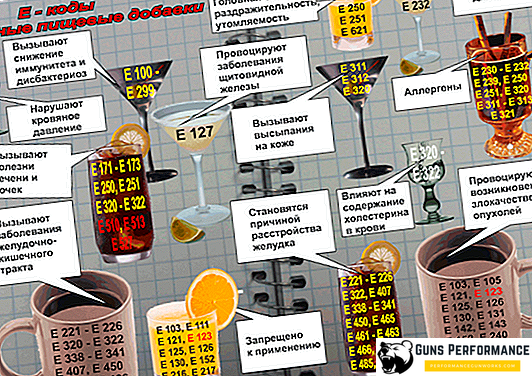
Phosphates that can be consumed can impair calcium absorption, which can lead to osteoporosis. Saccharins are capable of causing tumors, such as the bladder, and aspartame can be the most harmful to sodium glutamate. Such substances in the process of heating food turn into powerful carcinogens, affect the composition of chemical elements in the brain, are dangerous for people with diabetes, and indeed have a lot of destructive effects on the body.
Effect on the body of food additives
For a considerable period in the history of the existence of a wide variety of food additives, they still showed their own benefit. Additives have played an important role in improving the taste of food, extending shelf life, as well as improved other positive characteristics.
Sodium nitrates, which are highly demanded by the meat and sausage industry and are known as E250, in spite of their danger, impede the development of many dangerous diseases, including botulism. Denial of the negative impact of food additives is the path to nowhere. Sometimes manufacturers seeking to extract the maximum benefits for themselves, seek the help of scientists, so that they create food that is not completely edible for human organisms. As a result, including humanity, there are more and more new diseases, allergic reactions of skin diseases, as well as just a negative effect on the body. Therefore, it is necessary to treat with extreme caution not only obviously harmful substances, but such additives as: E450, E476, E500, E330, E1422, E202, E171, E200, E422, E331, E220, E160a, E471, and E211.
Recommendations on the use of food additives

When consuming nutritional supplements, it is advisable to adhere to the following recommendations:
- To study labels on products and try to choose those that contain a minimum of E-additives;
- Do not use unfamiliar products, especially if they contain a lot of various additives;
- If possible, avoid foods rich in sugar substitutes, flavor enhancers, thickeners, preservatives, and dyes;
- Opt for natural and fresh products.
Nutritional supplements and people's health are terms that are increasingly becoming compatible. There are many surveys in the world, the results of which reveal new facts. Немало современных ученых полагают, что рост пищевых добавок искусственного происхождения в рационе людей с одновременным уменьшением потребления свежих натуральных продуктов, может относиться к основным причинам возрастания случаев заболеваний рака, астмы, ожирения, диабета и депрессий.












